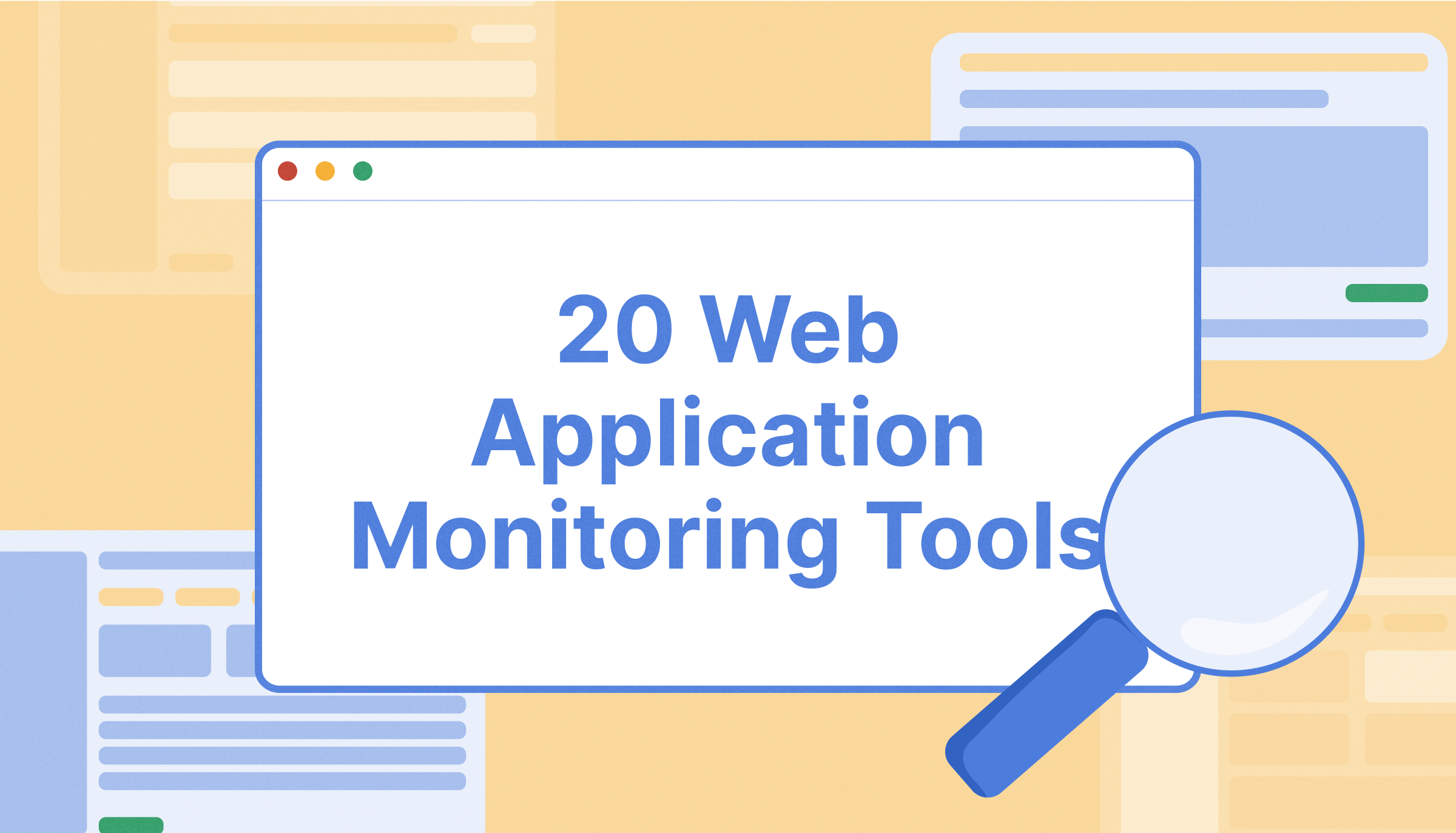
Whether you run your web app or rely on third-party services such as HubSpot, Slack, Basecamp, and Gmail, staying on top of web applications has become a part of many businesses’ daily business activities.
As a result, modern web application monitoring software has become necessary for every company.
Web application monitoring software allows users to monitor and assess various aspects of web apps, including functionality, efficiency, and performance.
Therefore, we want to look at the top 20 web application monitoring solutions in 2024. We compiled a list to help you choose the best web application monitoring solution. So let’s start with it.
20 Best Web Application Monitoring Tools You Should Consider Today
Before we explore the tools for overseeing performance, let’s highlight StatusGator, a bonus solution that enhances monitoring your web apps, hosted apps, websites, and other external services.
1. StatusGator
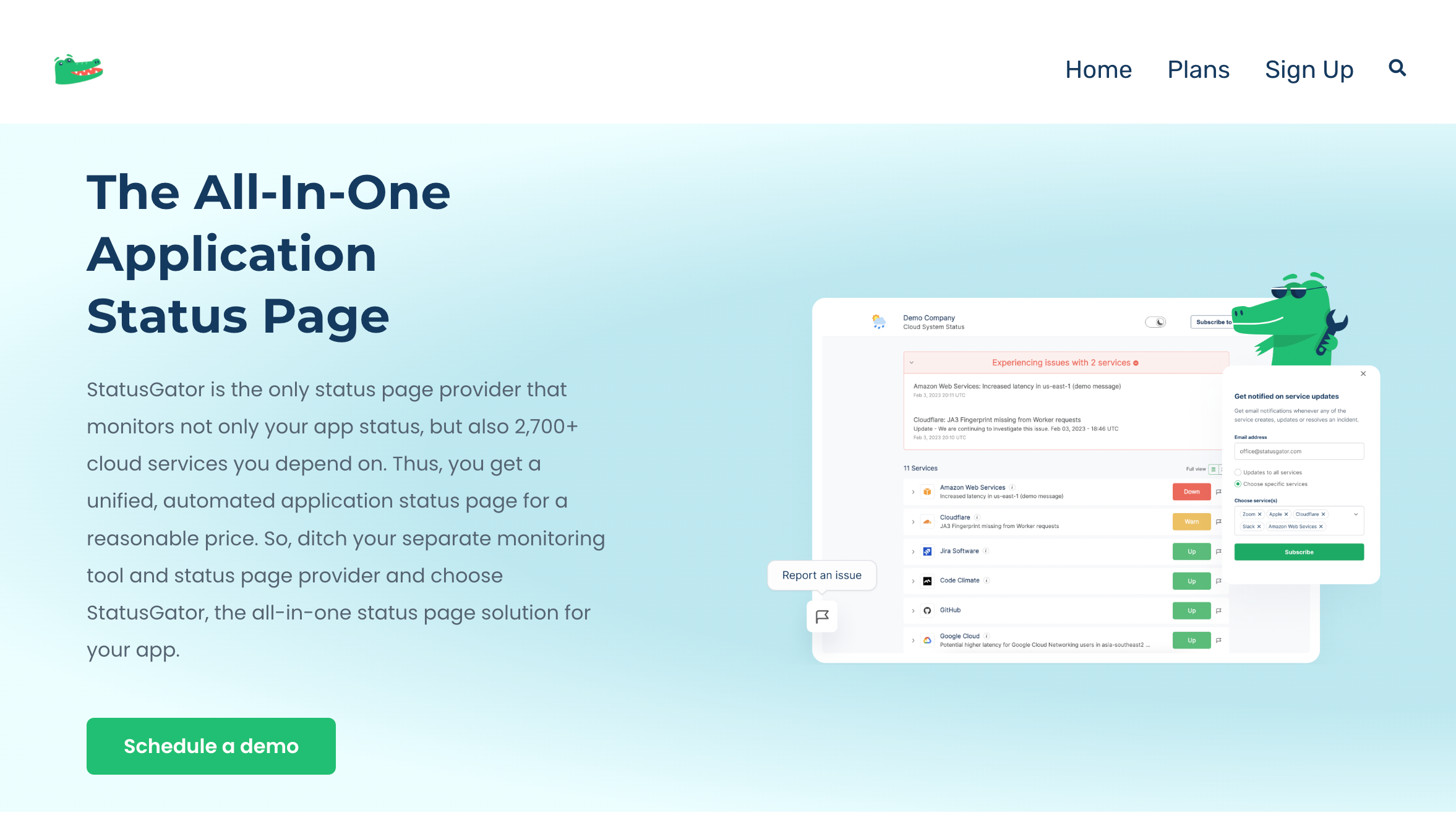
StatusGator can enhance the way you monitor web applications and the third-party services they rely on. This platform allows you to create both internal (private) and public status pages to service as a central source of uptime of your dependencies.
Internal status pages are designed for your IT team to view the status of all your web apps, cloud providers, and websites in one place. On the other hand, public status pages enable you to communicate incidents to your users and customers.
No matter which web apps you rely on, StatusGator provides timely, accurate updates about their status, including maintenance, uptime, downtime, and specific incident details. You can view these updates directly on the status pages. Additionally, StatusGator offers versatile alerting options through instant messages on platforms like Slack, MS Teams, as well as via email, SMS, webhooks, and API.
Monitoring more than 3,500 services, StatusGator ensures that both your internal teams and external users are consistently informed about the status of your hosted applications and other dependencies.
Key Features
- Web app monitoring – built-in support for monitoring over 3,500 cloud providers, SaaS, and web apps, including major platforms like Google Workspace, Trello, AWS, Zoom, Stripe, etc.
- Website monitoring – enables monitoring of website uptime to ensure your online presence is always accessible
- Unified status pages – Offers both public and private status pages within a single product, simplifying how incidents and statuses are managed and communicated
- Custom monitor – enables you to publish incidents manually to your status page
2. Site24x7
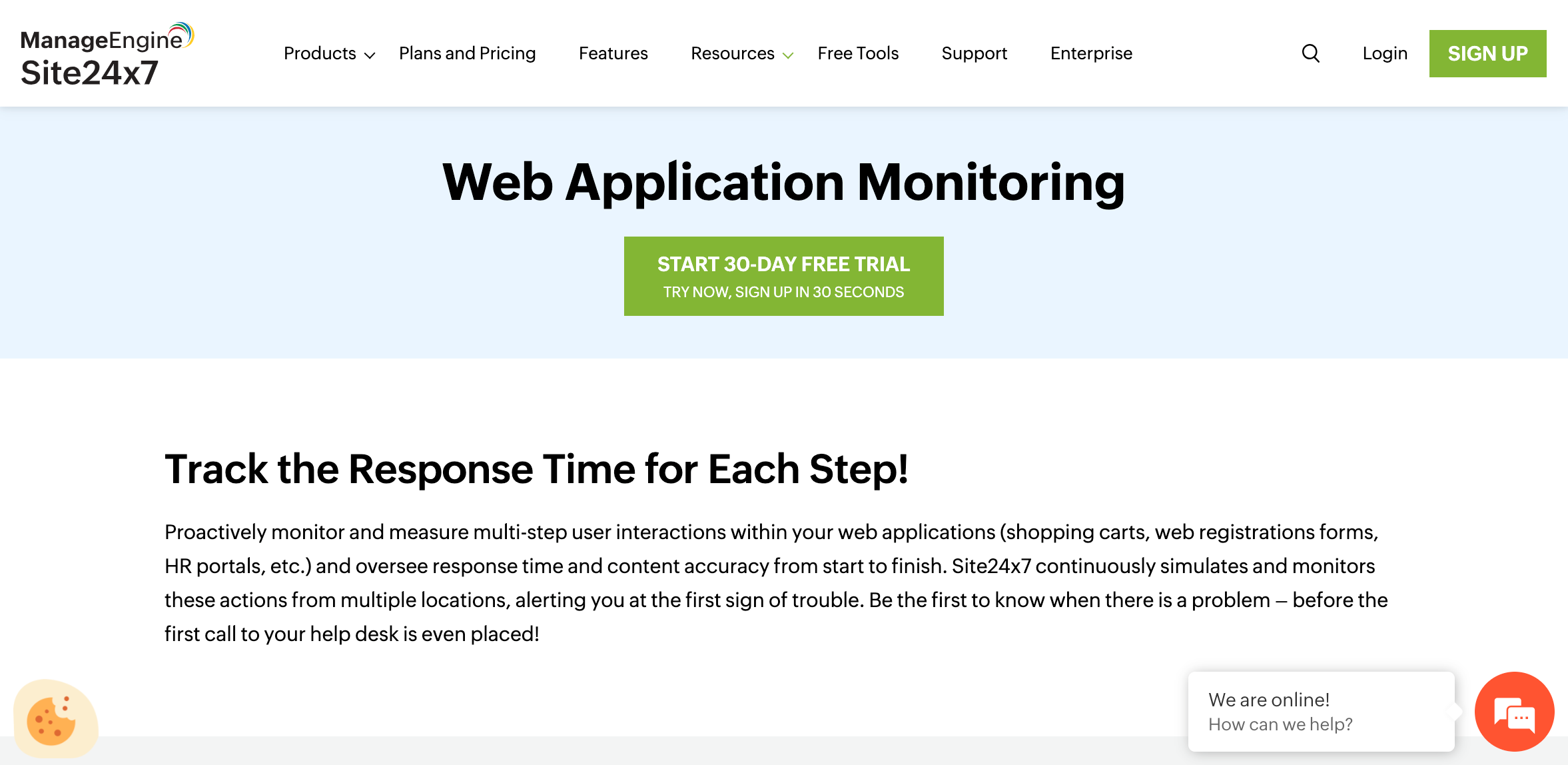
Designed for DevOps and IT teams, Site24x7 covers all web application needs. This includes application performance monitoring (APM), an AI-powered tool that analyses critical performance metrics. One key feature is synthetic transaction monitoring, which enables users to simulate user interactions and identify potential bottlenecks in their web applications’ performance.
Key Features
- Real-time monitoring
- Synthetic monitoring to simulate user interactions
- AI-powered
- APM
3. Pingdom
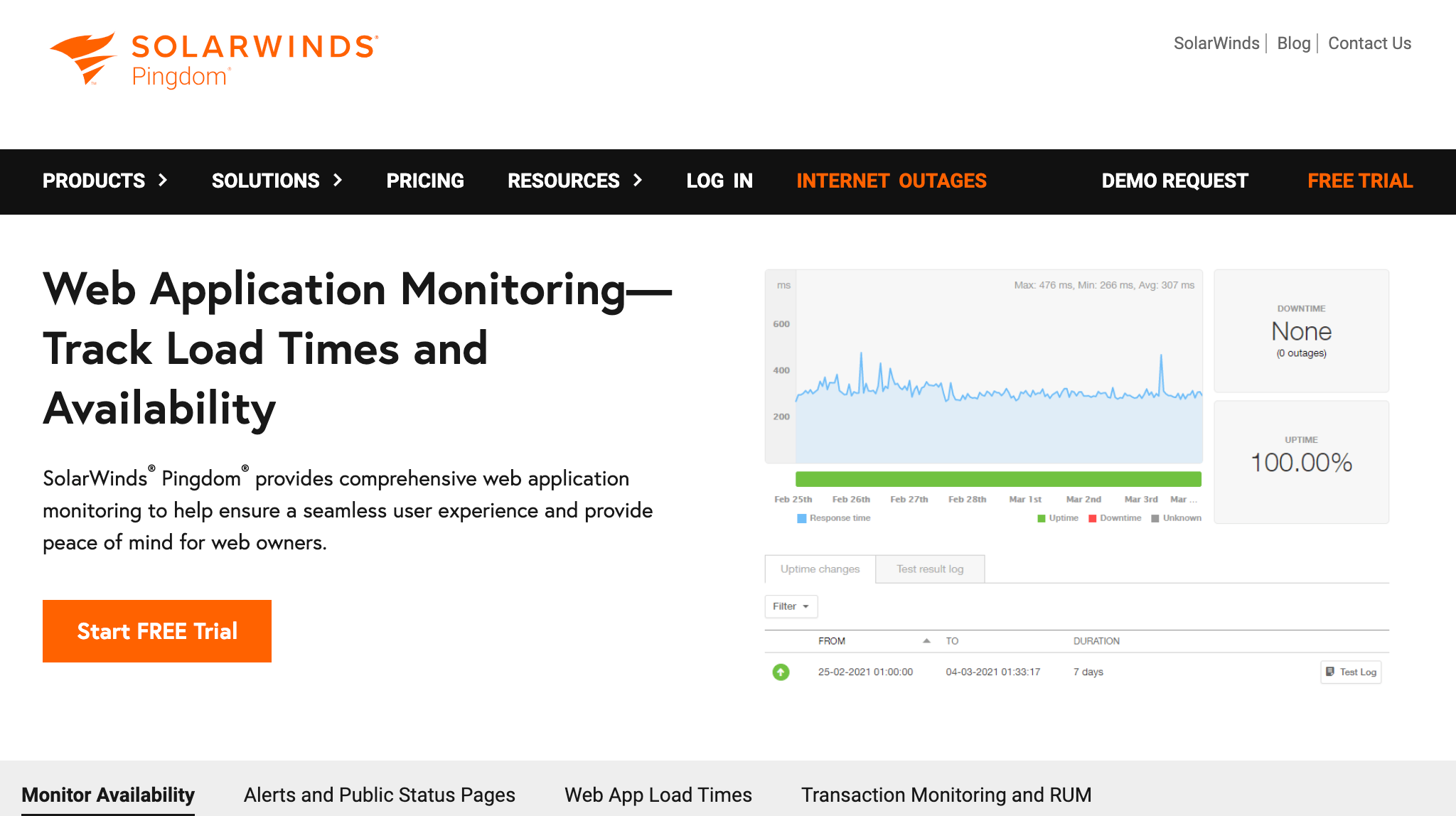
Designed for both web developers and web hosters, Pingdom is a widely used web app monitoring tool known for its simplicity. It offers a range of monitoring tools, including transaction, synthetic, real-time, and uptime monitoring. With detailed reports, real-time alerts, and global monitoring locations, Pingdom is focused on business needs.
Key Features
- Page speed monitoring
- Synthetic monitoring
- Transaction monitoring
4. AppDynamics
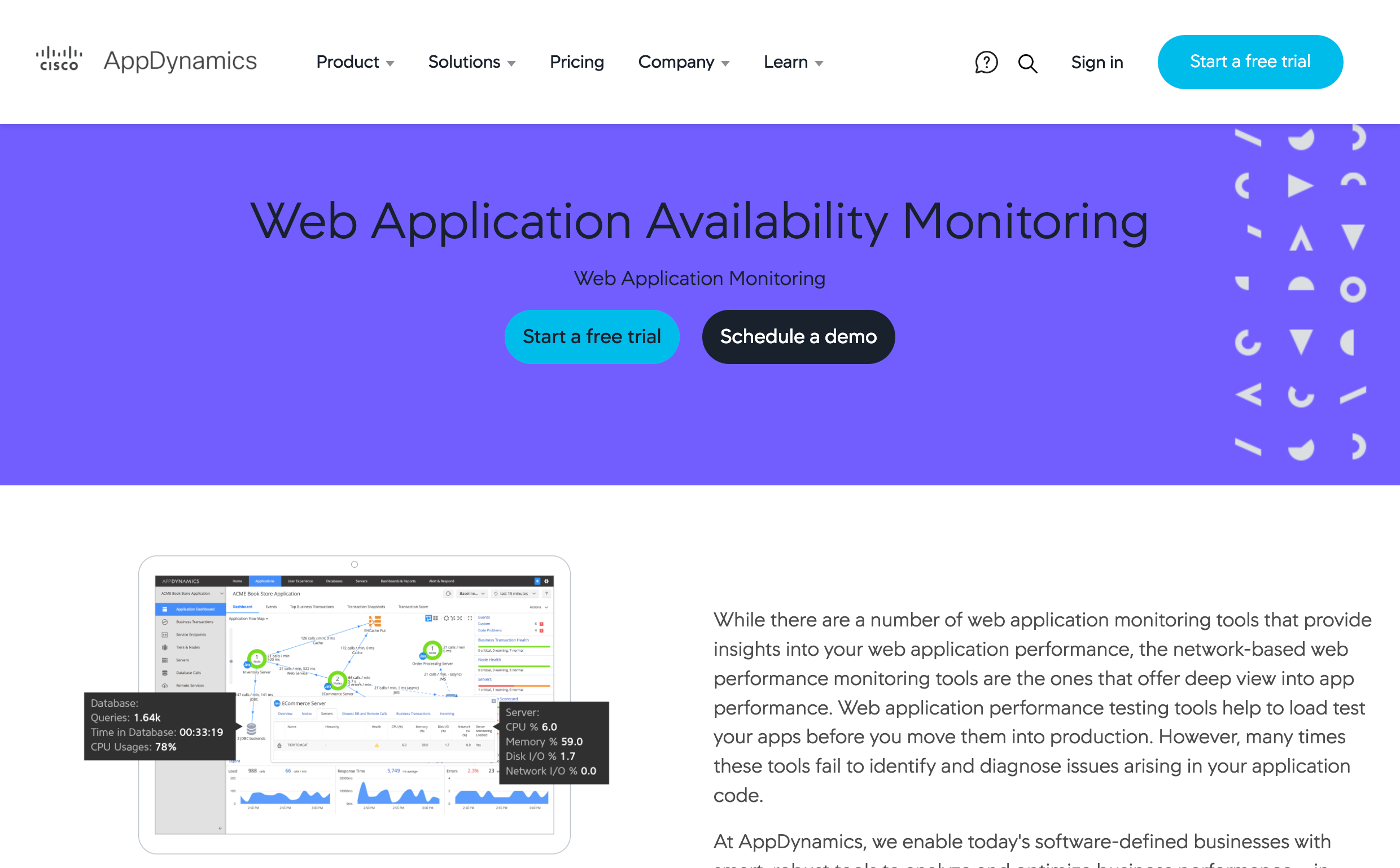
AppDynamics is an application performance monitoring solution that provides visibility into your applications’ performance. It offers end-to-end monitoring, advanced analytics, and AI-powered insights. Machine learning can resolve anomalies and issues in real-time, and workflow environments are simplified for an efficient user experience.
Key Features
- End-to-end APM
- Advanced analytics and AI-powered insights for issue resolution
- Business impact analysis
5. New Relic
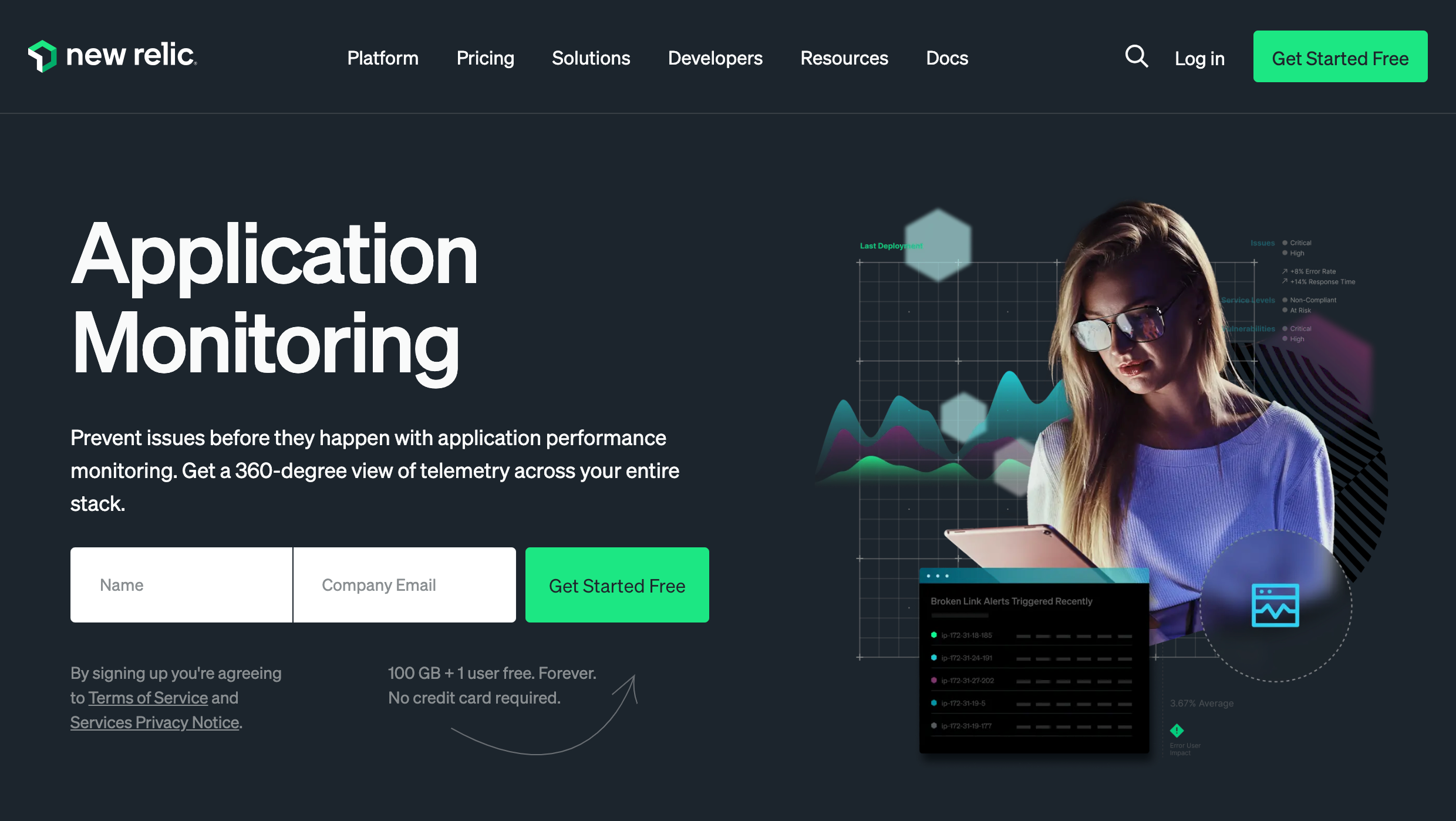
New Relic is an observability platform that prides itself on full-stack visibility into the performance of your applications. New Relic offers a simplified platform for users to optimize performance and monitor their web apps effectively. With real-time monitoring, analytics, and AI-driven insights – New Relic empowers teams to deliver better software faster.
Key Features
- Full-stack observability
- Real-time monitoring and alerting
- AI-driven insights to optimize performance
6. Dynatrace
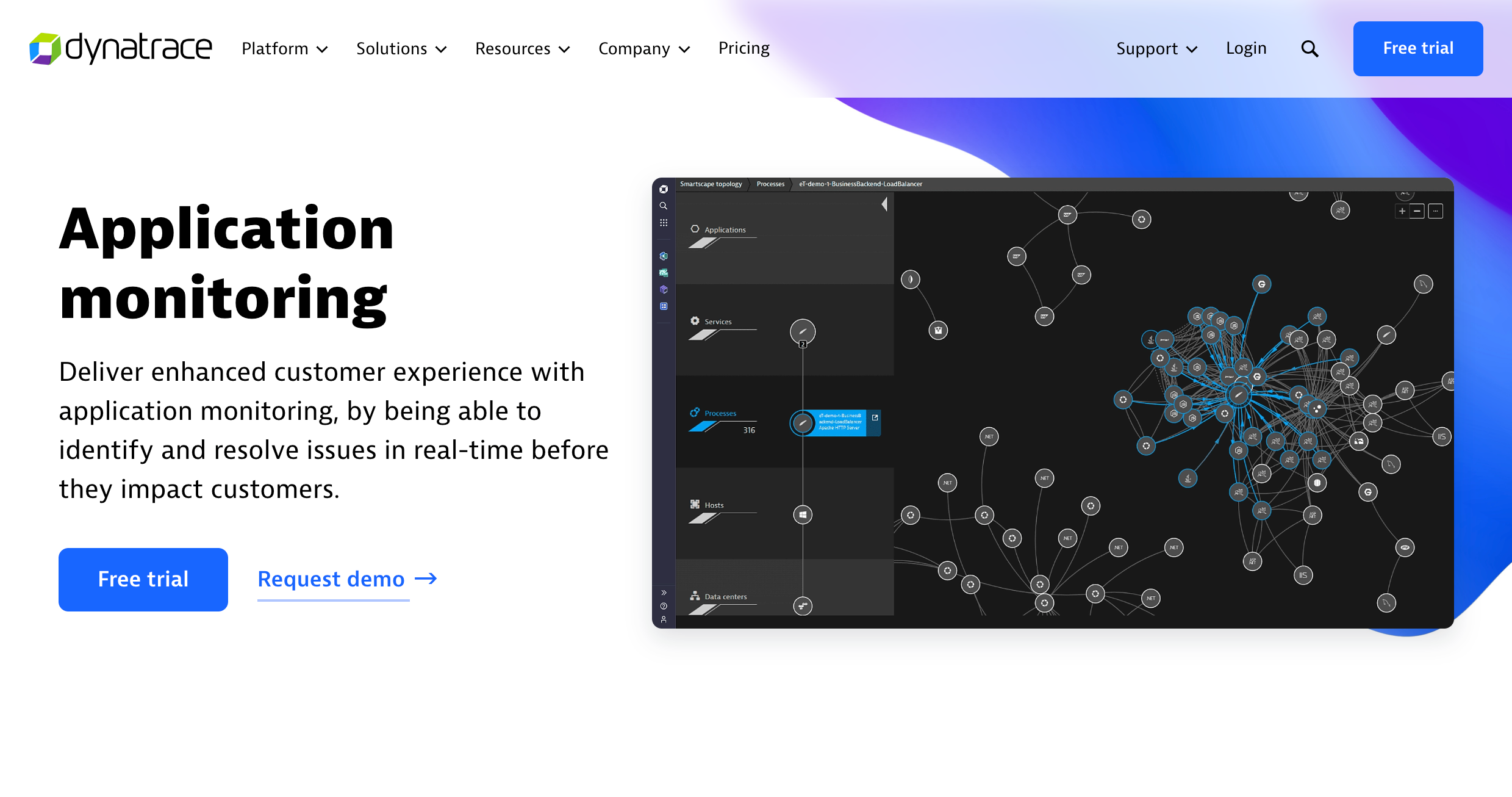
Dynatrace is an AI-powered observability platform that provides automatic and intelligent monitoring of your entire application stack. With root cause identification, continuous discovery, real-time analysis, and more – Dynatrace focuses on the user experience. Simplified workflow environments, health metrics, and over 650 integrations are just some features that contribute to a straightforward user experience.
Key Features
- AI-driven
- Continuous discovery, real-time analysis, and root analysis
- Over 650 integrations
7. AppOptics by SolarWinds
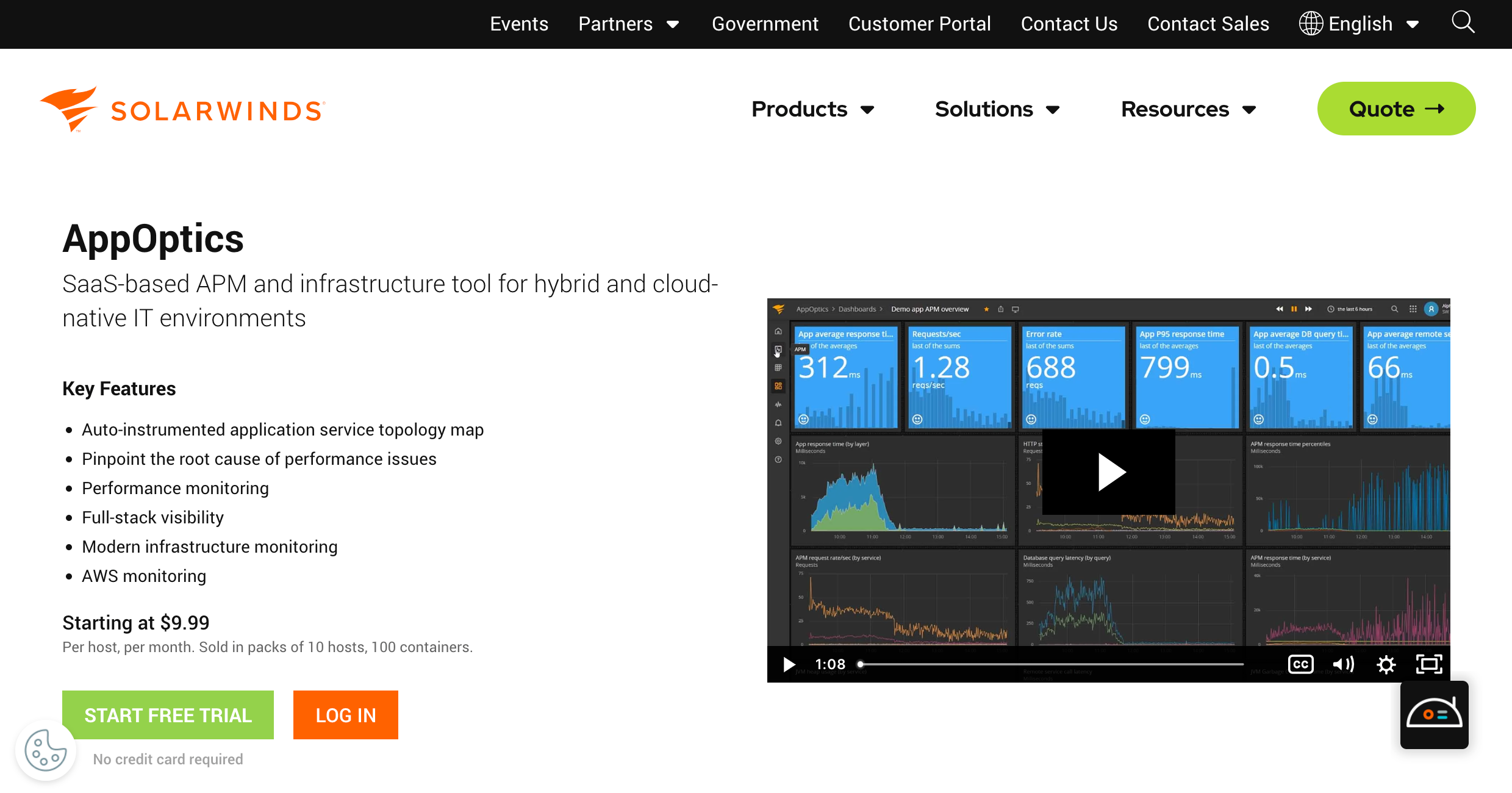
Another product by SolarWinds, AppOptics provides deep visibility into the performance and health of your web applications. Features like distributed tracing, code profiling, and customizable dashboards help teams establish performance metrics that can be used to optimize their user experience. Root analysis, complete stack visibility, and over 150 integrations make AppOptics a popular tool for web application monitoring.
Key Features
- Distributed Tracing and code profiling to establish performance metrics
- Root cause analysis and real-time problem resolution
- Customizable dashboard and notifications
8. Datadog
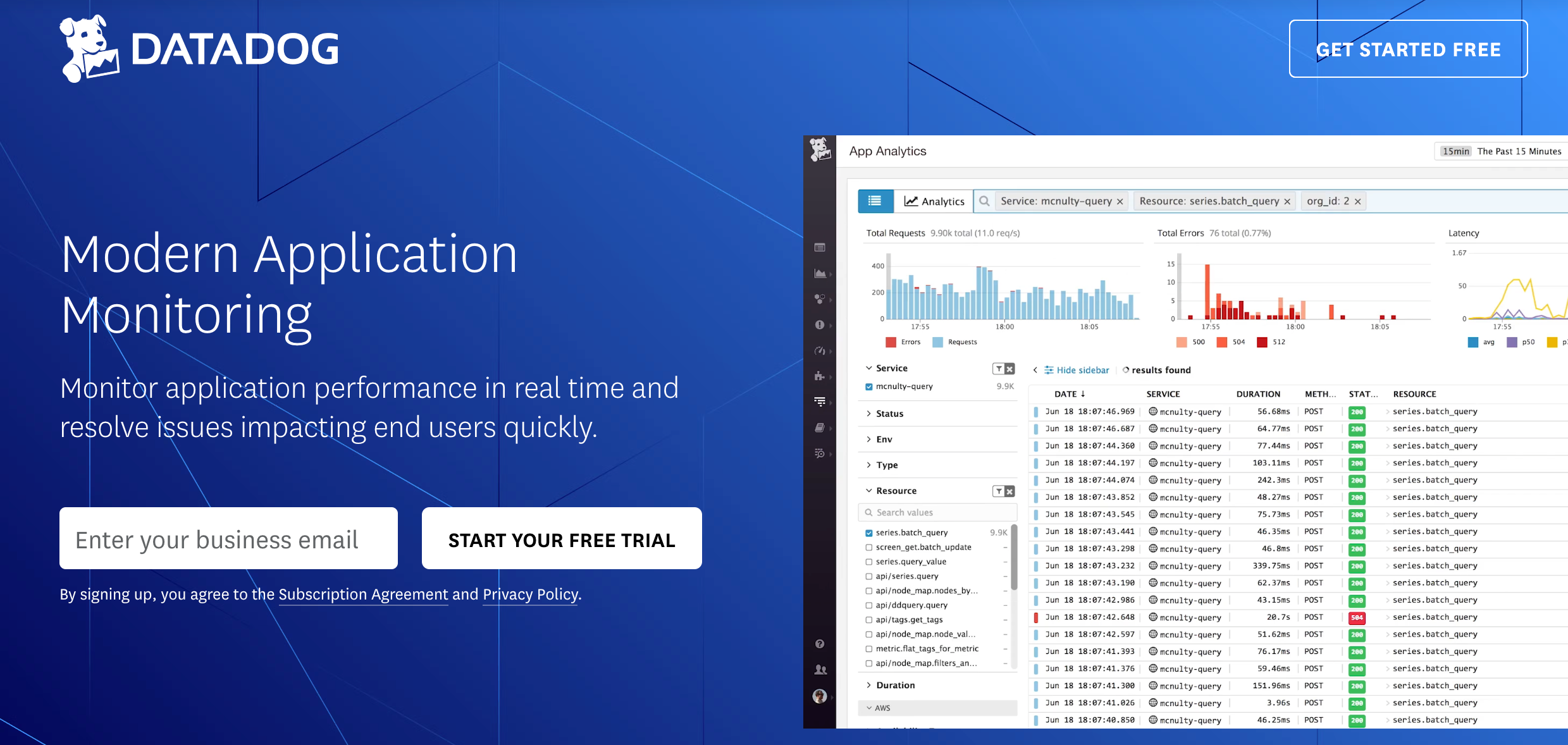
Datadog is a robust monitoring and analytics platform that provides full-stack observability for modern applications. It enables teams to monitor, troubleshoot, and optimize their applications in real-time to prevent long-term issues. Features like distributed tracing, log management, and AI-powered insights mean Datadog can help you monitor your web apps.
Key Features
- Full-stack observability
- Distributed tracing for tracing requests across complex architectures
- AI-powered insights
9. Splunk
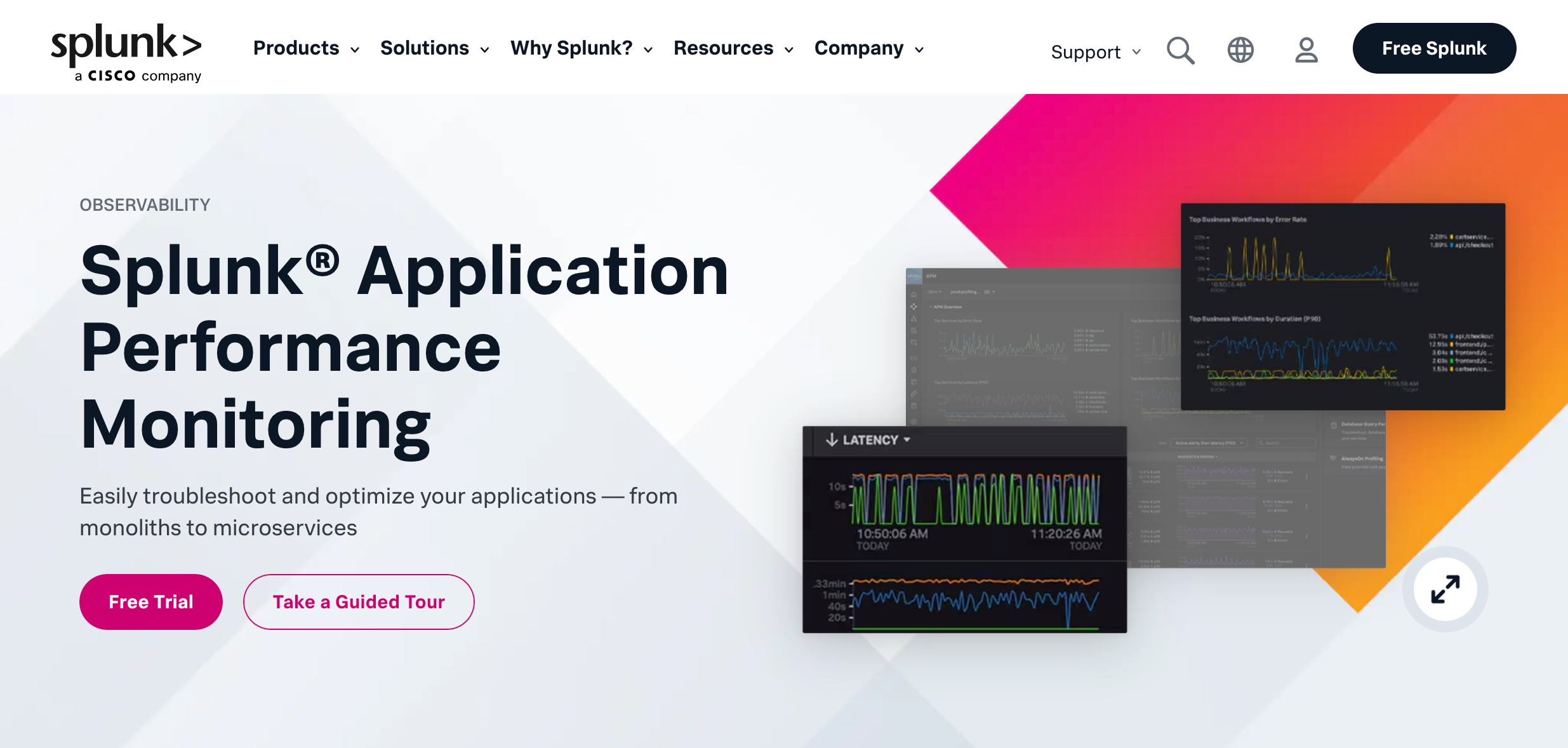
Splunk is a popular data platform that can provide real-time insights into your organization’s web application data. With powerful monitoring and analytics capabilities, Splunk enables you to monitor, investigate, and act on machine-generated data based on your web apps.
Key Features
- Real-time application performance monitoring and analytics
- Security analytics for detecting and responding to security threats in real-time
10. Stackify
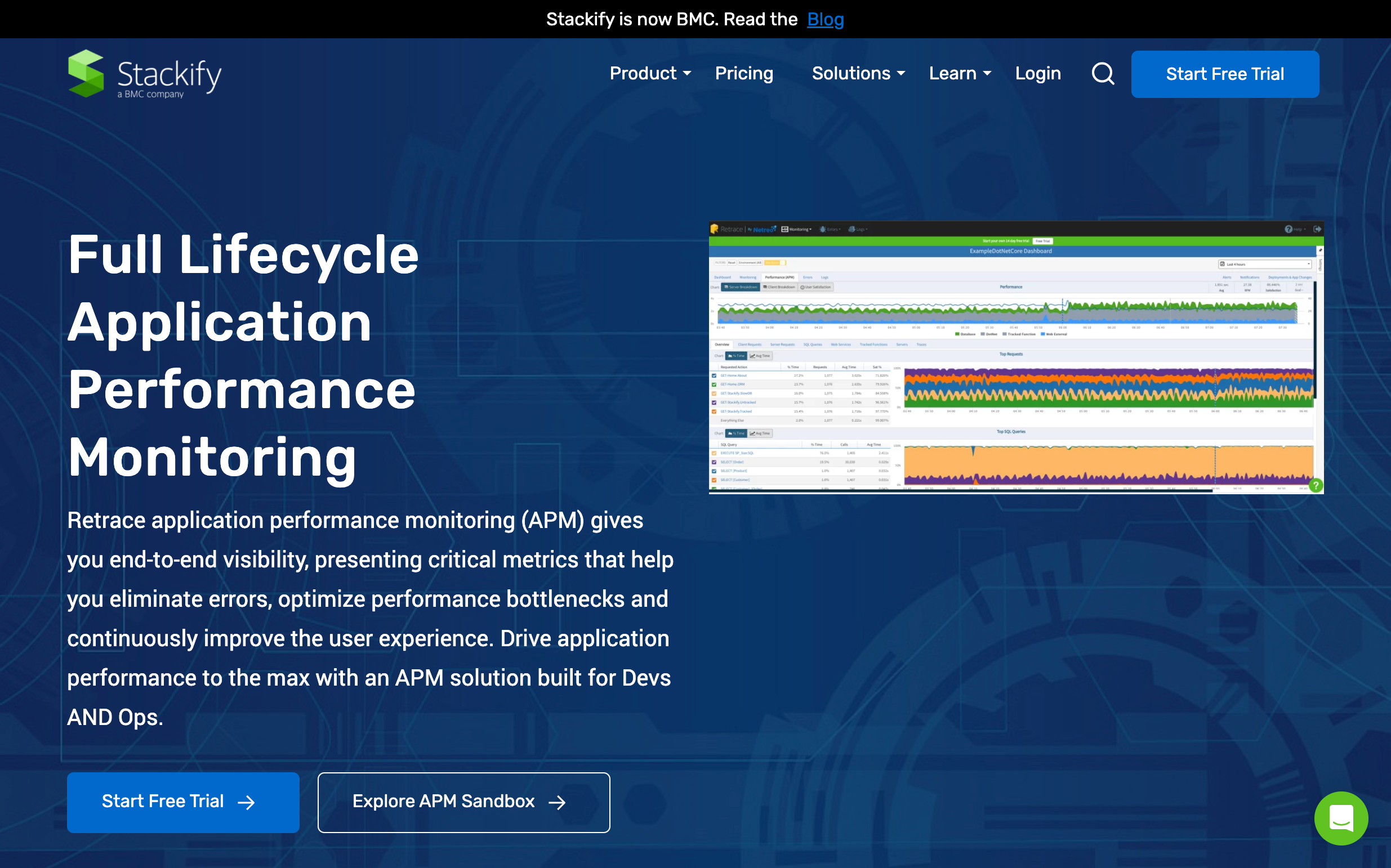
Stackify is an APM platform designed to help developers and DevOps teams monitor their apps’ performance. With features like error tracking, code-level insights, and application profiling, Stackify provides deep visibility into application behavior. In 2023, Stackify joined Netreo to become a full-stack observability platform.
Key Features
- Code-level insights for identifying performance bottlenecks
- Error tracking
- Application profiling
11. Dotcom-Monitor
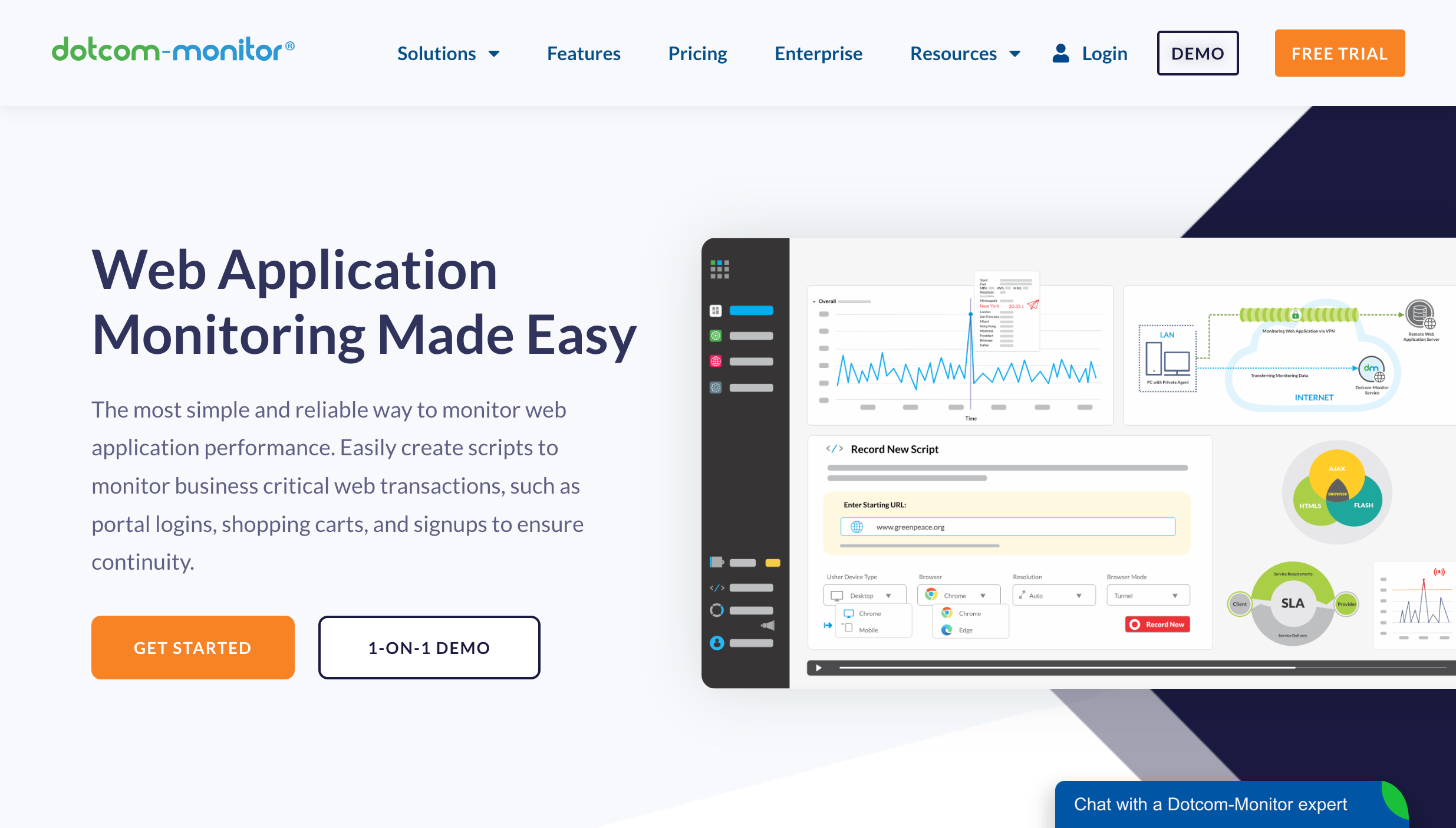
Dotcom-Monitor is a synthetic monitoring platform designed to ensure the performance and availability of your web apps. With features like global monitoring locations, customizable alerting, and detailed performance reports – Dotcom-Monitor helps businesses proactively identify and resolve issues before they reach users.
Key Features
- Global monitoring locations
- Customizable alerting
12. Sentry
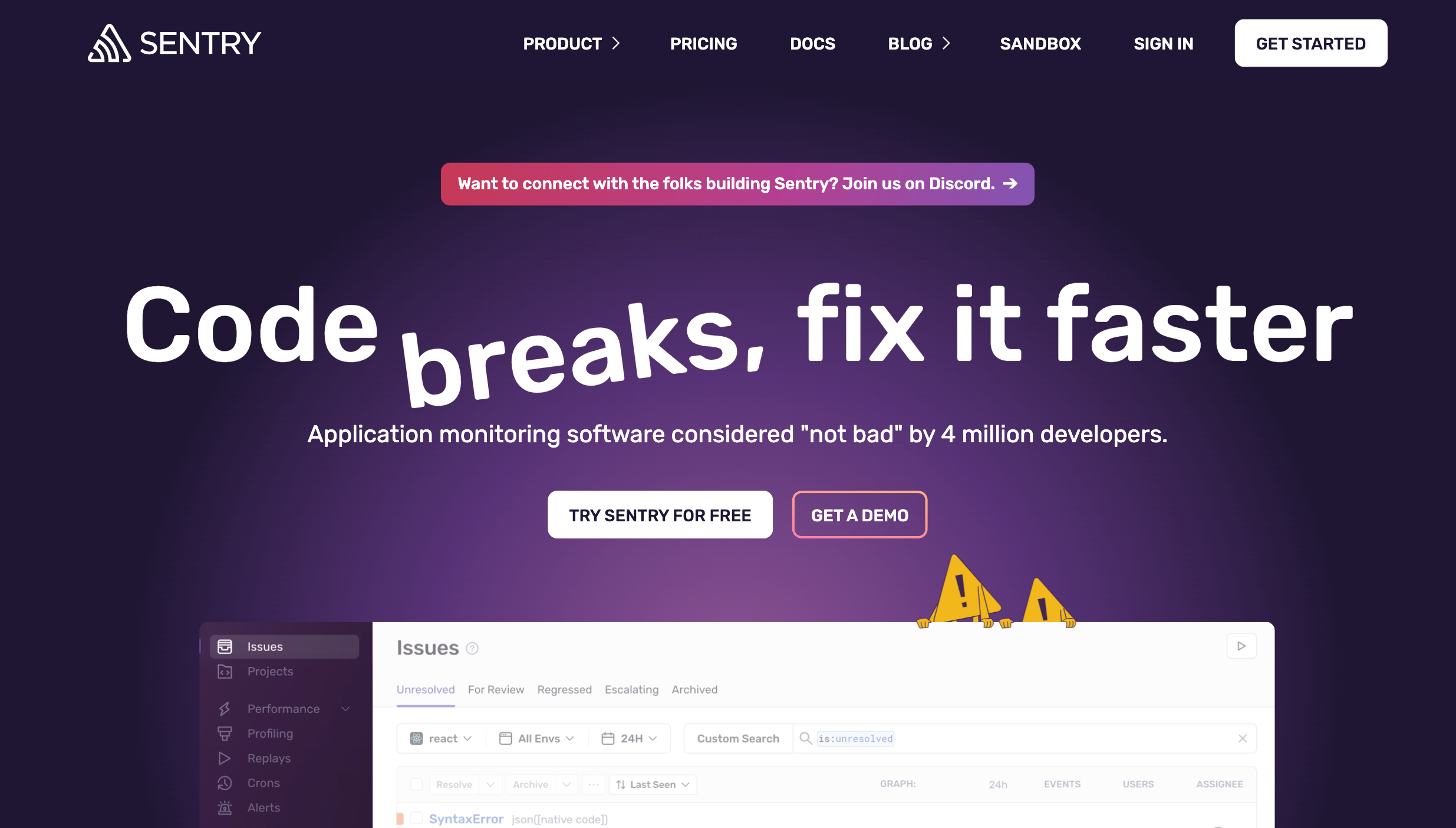
Sentry specializes in error monitoring and logging and is trusted by developers worldwide to track, prioritize, and fix application errors in real-time. Some features include customizable error tracking, release monitoring, and performance insights. Sentry aims to empower teams to deliver high-quality software with confidence.
Key Features
- Customizable error tracking
- Release monitoring to track errors introduced by new code deployments
- Performance insights
13. ManageEngine
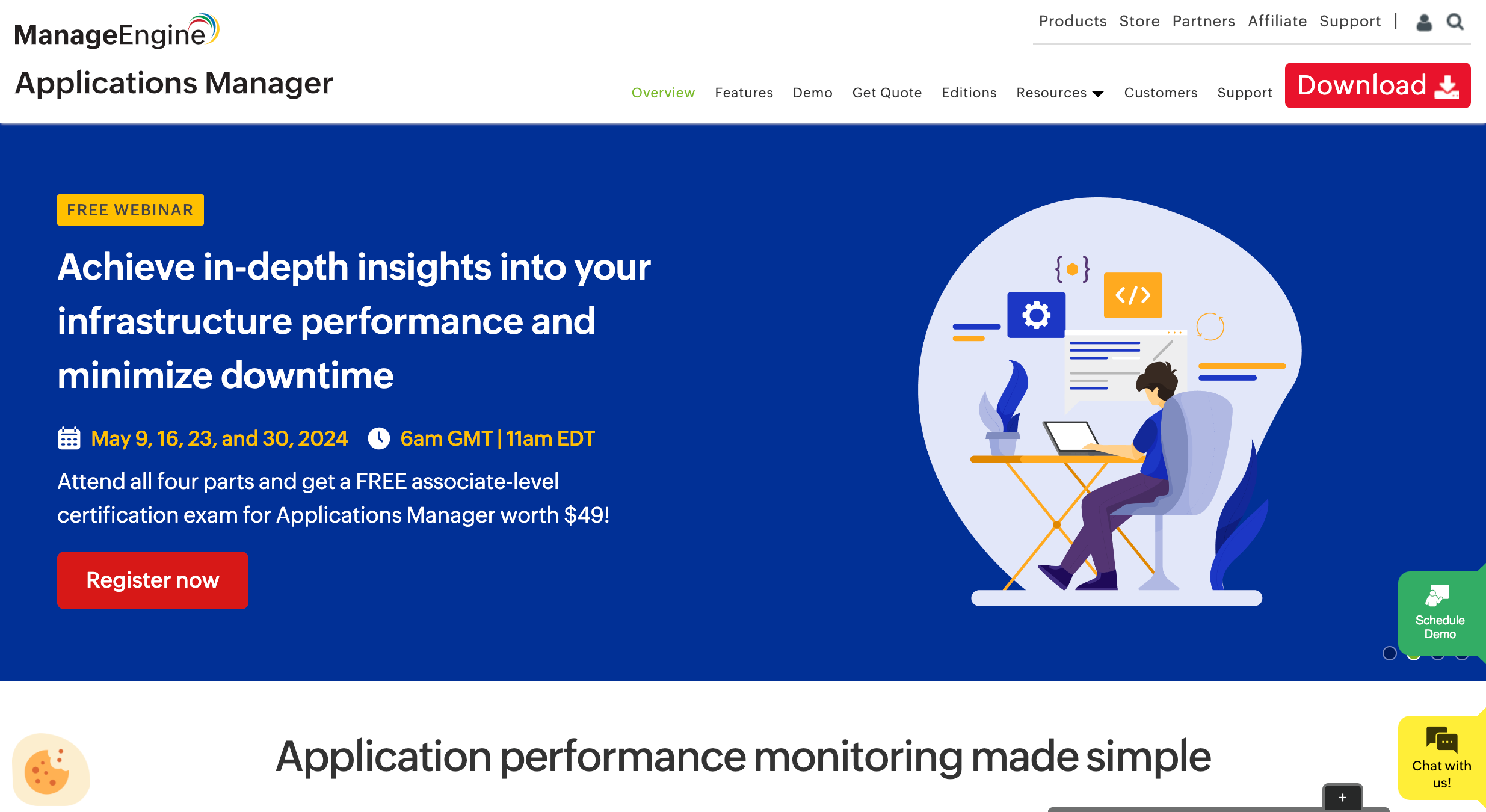
ManageEngine offers a suite of IT management solutions. ManageEngine enables teams to detect and resolve performance issues quickly. Namely, the helpful features are their web app monitoring, customizable dashboards, and automated troubleshooting.
Key Features
- Real-time monitoring
- Customizable dashboards
- Automated troubleshooting
14. Nagios
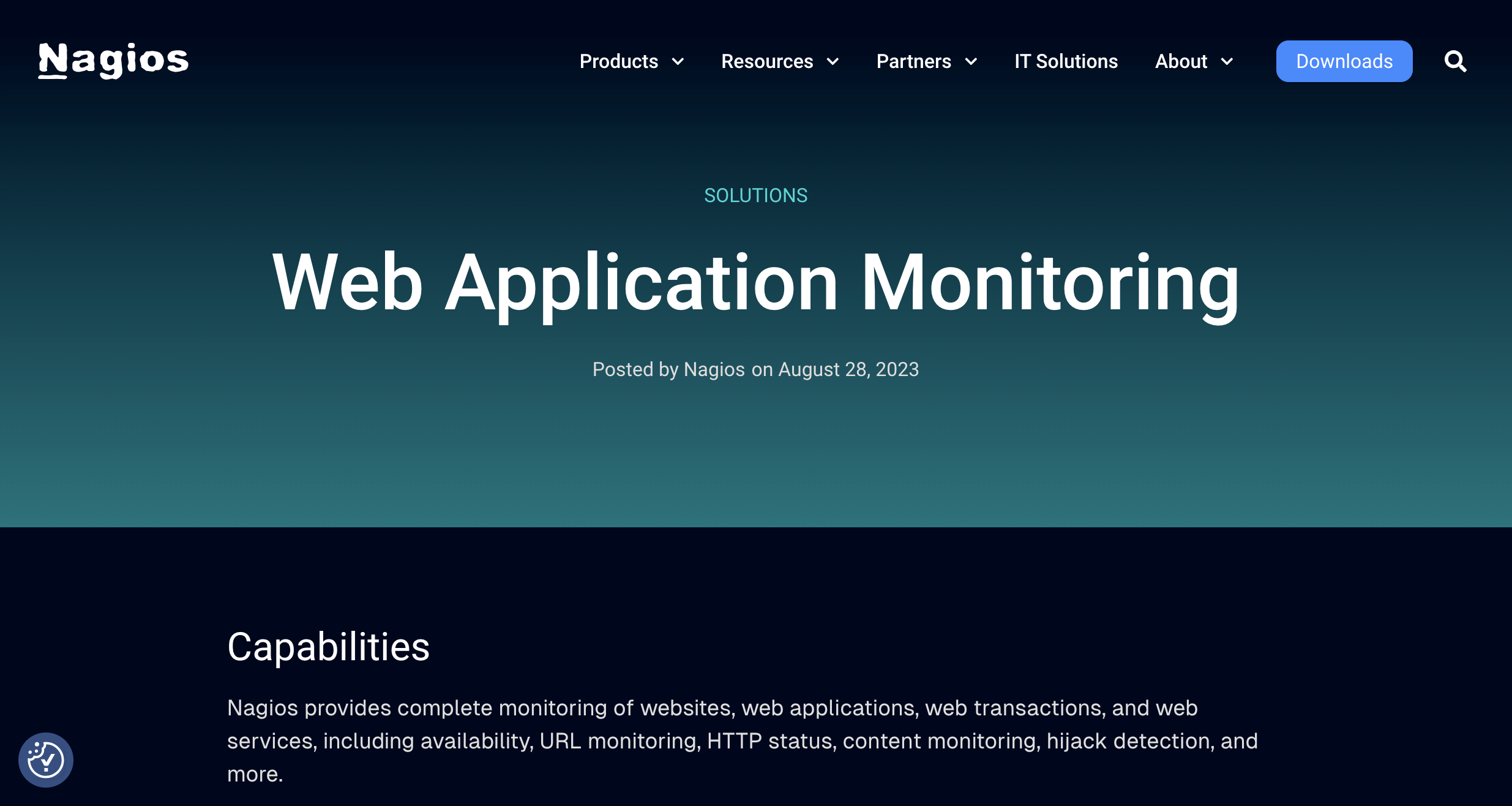
Nagios is a powerful infrastructure that compiles various IT elements into an all-in-one solution. This includes web app monitoring with features such as customizable monitoring templates, real-time alerting, and metric reporting. Nagios provides deep visibility into the health and status of networks, systems, and applications.
Key Features
- Alerting mechanisms to notify administrators
- Reporting capabilities
15. IBM Instana
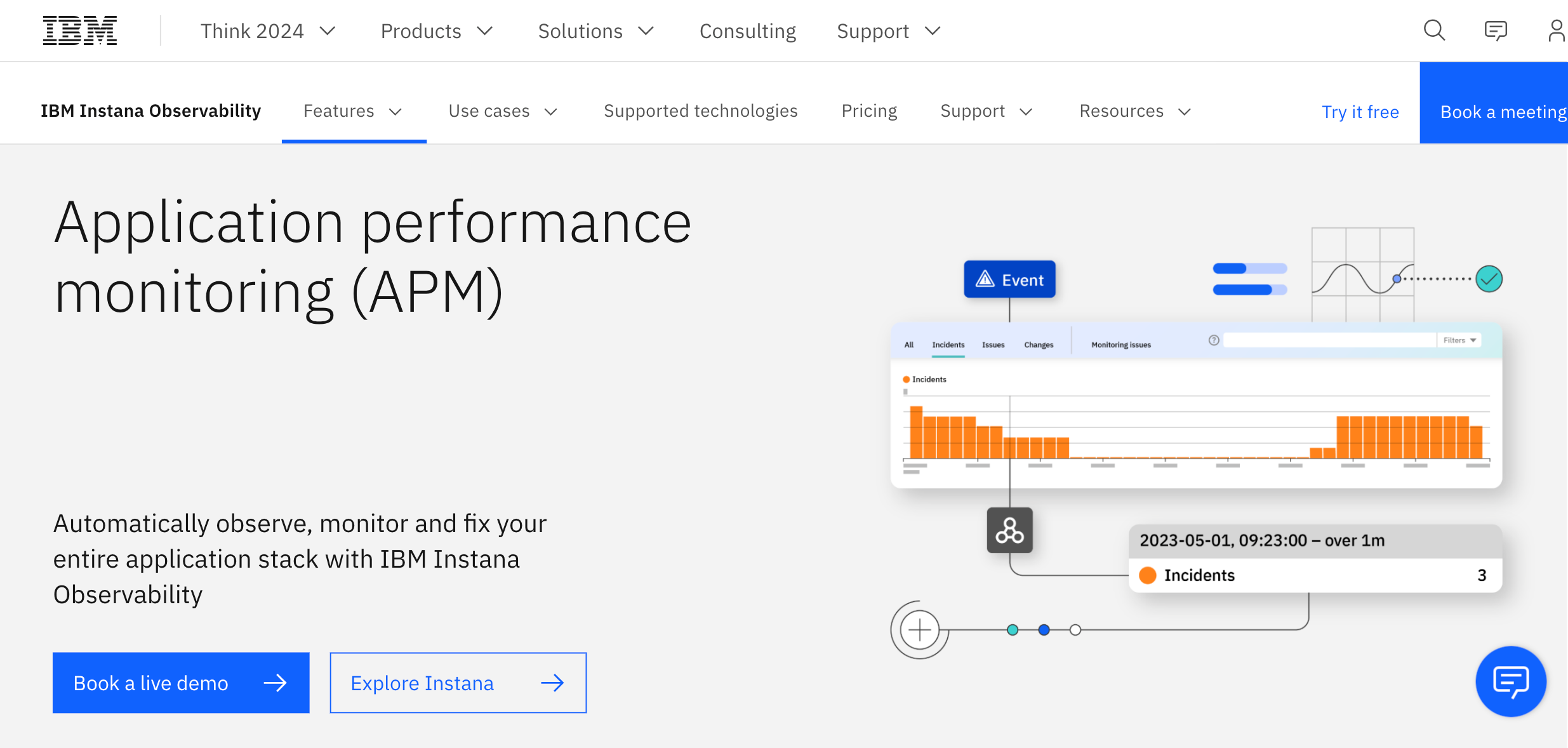
IBM Instana is an AI-powered application performance monitoring (APM) solution that offers consistent application stack monitoring. With features like real-time performance insights, automatic tracing, and anomaly detection, IBM Instana helps organizations optimize the performance and availability of their applications.
Key Features
- Real-time performance insights and anomaly detection
- Automatic tracing to monitor requests and dependencies
16. Uptrends
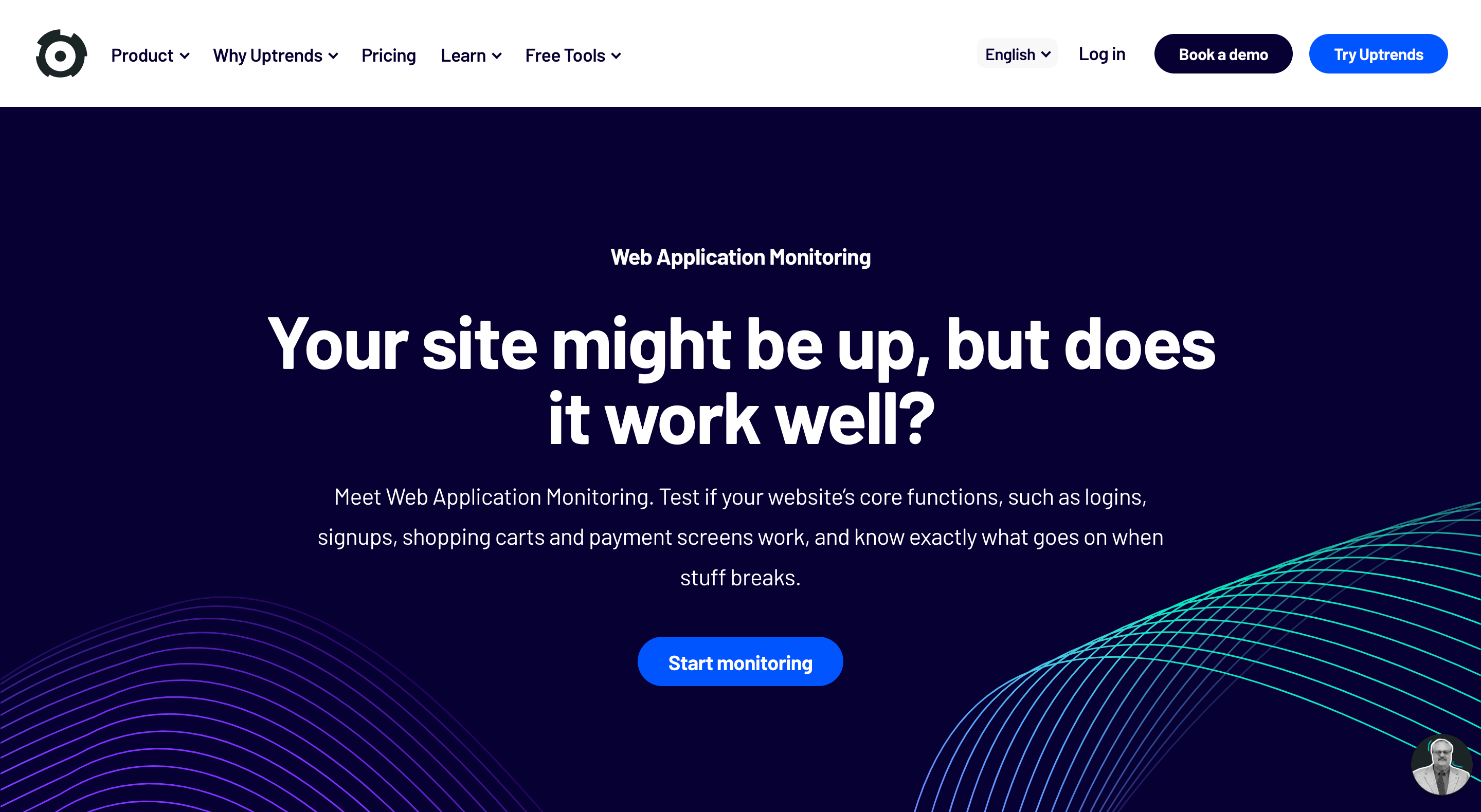
Uptrends provides website monitoring solutions designed to ensure the availability and performance of your web applications. With features like global checkpoint monitoring from 233 locations, transaction monitoring, and advanced alerting – Uptrends offers detailed insights into the health and performance of your web apps.
Key Features
- Global checkpoint monitoring
- Transaction monitoring
- Advanced alerting with customizable thresholds and notification options
17. Veracode

As not an all-in-one web app monitoring platform, Veracode is a leading application security platform that offers security testing solutions for your apps. With features like static application security testing (SAST) and dynamic application security testing (DAST), Veracode helps businesses detect vulnerabilities in their code and web applications.
Key Features
- Static Application Security Testing (SAST) to analyze source code
- Dynamic Application Security Testing (DAST) to scan web applications
- Software Composition Analysis (SCA) to detect open-source vulnerabilities
18. LeanIX
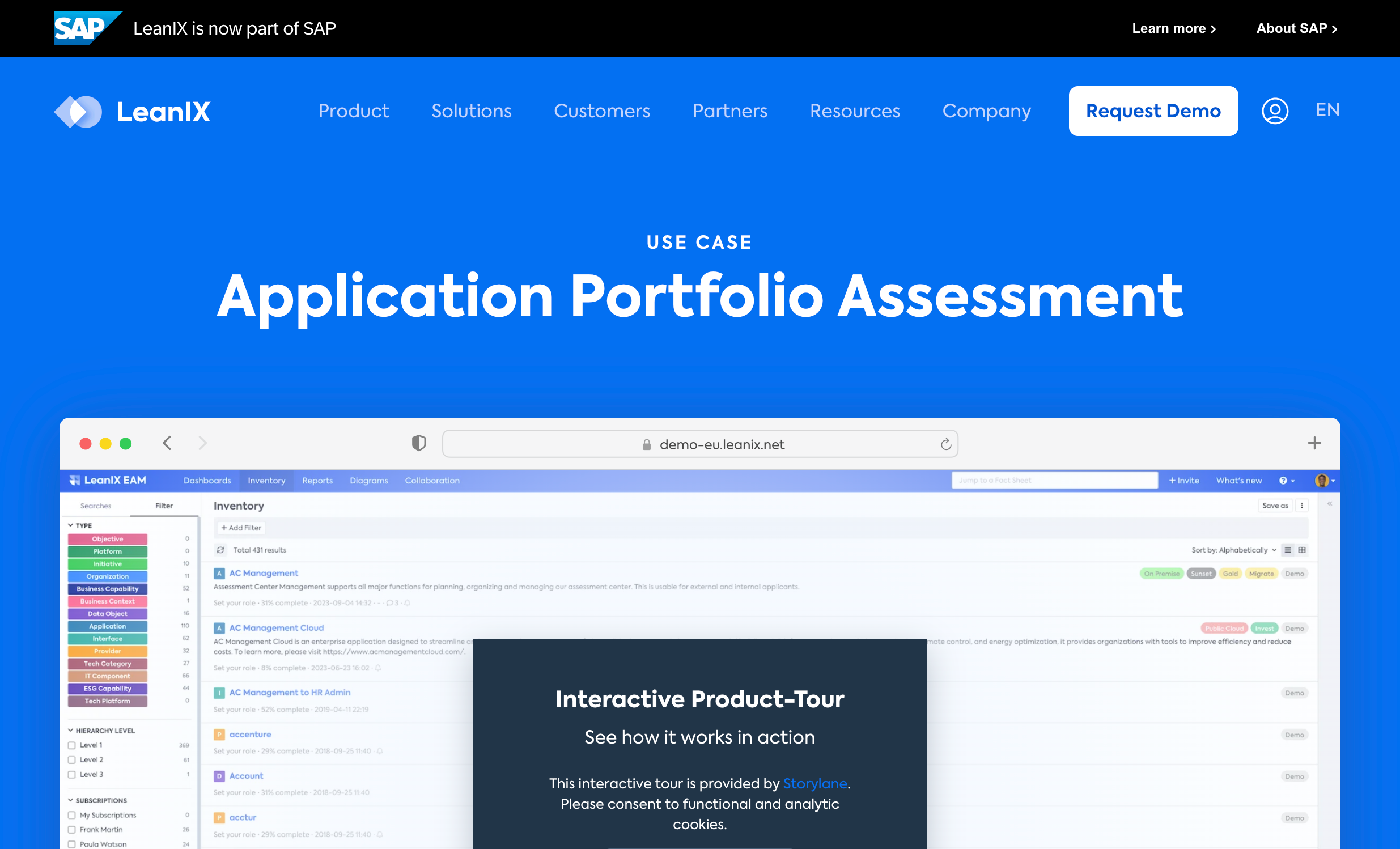
LeanIX is an Enterprise Architecture Management (EAM) platform that provides organizations with insights into their IT landscapes. While not specifically a web application monitoring platform, LeanIX offers features that can be useful for indirectly monitoring web applications. For example, its capability to visualize and map IT landscapes can help teams understand the interactions between the apps and underlying infrastructure components.
Key Features
- Visualization and mapping of IT landscapes
- Integration capabilities
19. Raygun
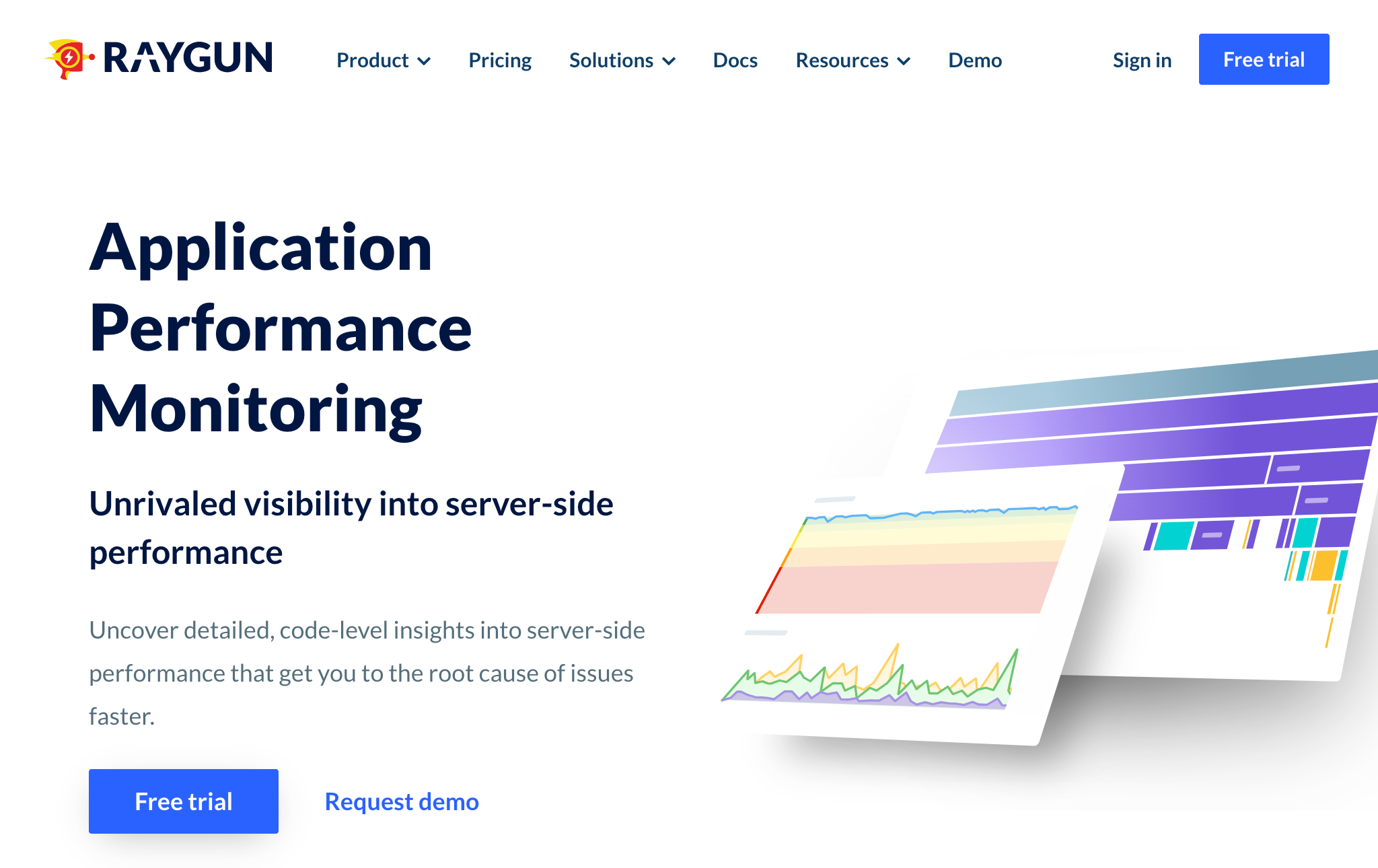
While not solely focused on web application monitoring, Raygun offers application monitoring and error-tracking solutions to help organizations detect, diagnose, and resolve software issues. For example, its real-time error-tracking capabilities can help teams promptly identify and address errors occurring within the apps. Like LeanIX, features such as this can be helpful in web application monitoring.
Key Features
- Real-time error tracking
- Performance monitoring tools
- Detailed insights
20. Logit.io
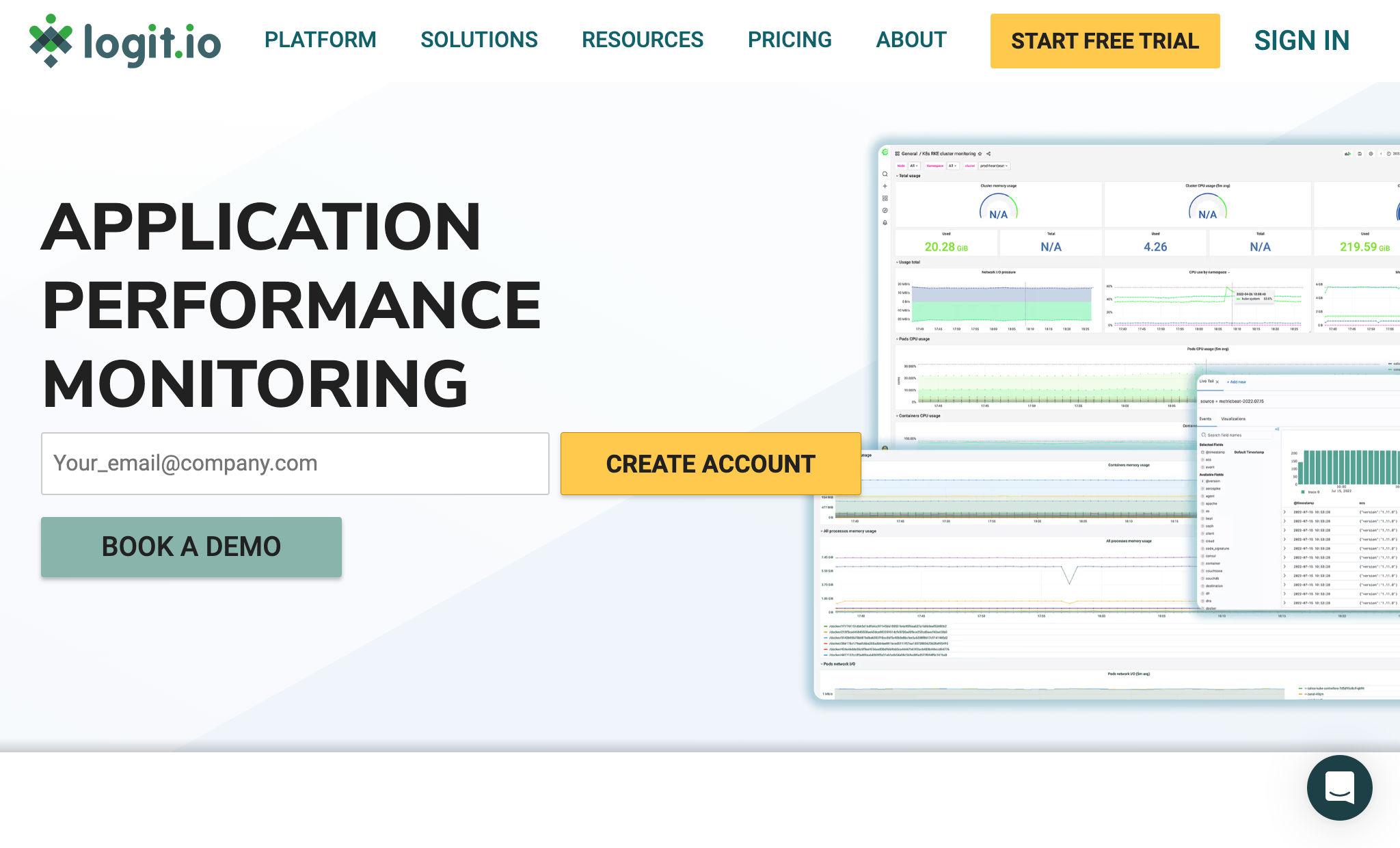
Logit.io specializes in observability solutions, providing organizations with insights into their IT infrastructure and applications. Logit.io’s observability platform offers features that can be beneficial for indirectly monitoring web applications. For example, its log management and analytics capabilities enable organizations to collect, analyze, and visualize web app data.
Key Features
- Log management and analytics
- Metric monitoring
What is Web Application Monitoring?
In short, web applications are applications and software accessed using a web browser. Whereas websites are more static, web apps are more dynamic and interactive. Since over 1 billion websites exist, we can’t imagine the number of web apps available.
Simply put, web application monitoring involves monitoring the apps you rely on. It involves consistently checking functionality, performance, safety, speed, and more. Web application monitoring software covers all of this.
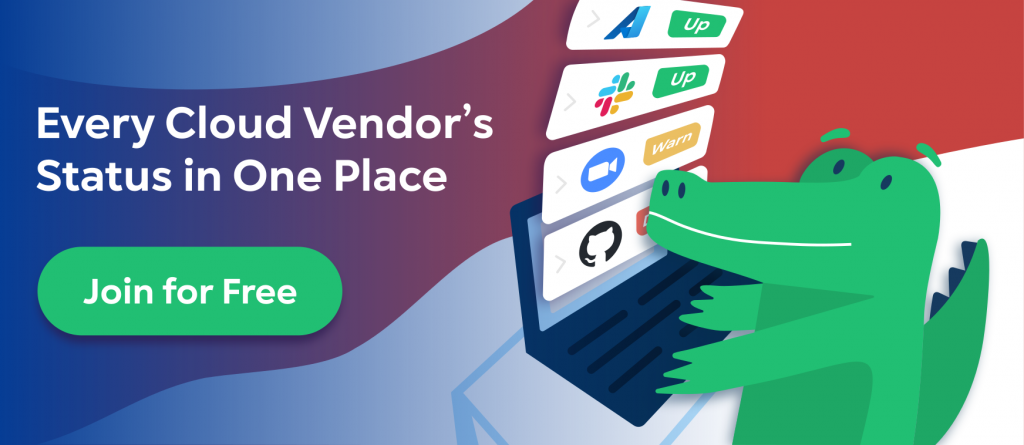
Importance of Monitoring Web Applications
Businesses will continue using web apps to establish customer bases, market their products, and sell their services or products via e-commerce platforms. Thus, web apps are a fundamental dependency for many businesses, so keeping on top of them is vital.
Critical features of web application monitoring tools
Some key features include:
- Real-time Performance Monitoring – Provides insights into key performance metrics like real-time response times and resource usage.
- Uptime Monitoring – Ensures continuous availability of your web application.
- Alerting and Notification – Customizable alerts notify administrators of threshold breaches or anomalies.
- End-user Experience Monitoring – Measures user perception of performance.
What Are the Key Features to Look for in Monitoring Software?
Alert Mechanisms and Notifications
Effective alerting mechanisms are vital for informing administrators and end users of issues or deviations from expected performance and availability. Consider monitoring tools that support various notification channels (SMS, Email) and customizable notifications.
Monitoring Web Transactions and Metrics
Seek monitoring solutions that provide detailed insights into transaction metrics to ensure your end users have a straightforward, seamless transaction experience. This includes response times, error rates, and throughput.
User Experience Monitoring
Insights into the user experience are crucial for any business, especially web application-based businesses. Consider monitoring tools that track page load times, transaction completion rates, and user interactions.
How Can You Choose the Right Monitoring Tool for Your Web Application?
Comparing Different Application Monitoring Tools
When choosing a monitoring tool, make sure to compare features. This can include:
- Scalability
- Ease of use
- Integration capabilities
- Cost
Look for intuitive interfaces, integrations, and scalability, too. Consider subscription plans and pricing models to ensure the tool is within your budget.
Benefits of Using a Specialized Monitoring Tool
Specialized tools offer focused features tailored for web applications, providing deep insights, customization options, and dedicated support. For a more specialized approach, choose a provider with responsive customer support for effective issue resolution to sort problems specific to your web app.
Why is Web Application Performance Monitoring Essential?
Web Application Performance Management
Effective performance monitoring provides insights into response times, resource usage, and overall health, aiding in proactive issue resolution and optimization.
Impact of Performance on End User Experience
Performance directly impacts user experience. Factors influencing end users include page load times, transaction completion rates, and security.
Real-time Monitoring vs. Periodic Monitoring
Real-time monitoring enables immediate detection of issues, ensuring timely intervention and mitigation. However, periodic monitoring may lead to delayed responses and potential user dissatisfaction.

FAQ
Q: Which tool can be used to monitor web applications?
A: Site24x7, Grafana, and Raygun tools can monitor web applications. They have similar features, some differences, and can suit different budgets. To find out which is right for you, consider their diversity of features to see what best suits you and your web apps.
Additionally, StatusGator monitors web applications and websites. Unlike other web app monitoring tools, it can unify the statuses of all your web apps into a single status page, offering status changes, analytics, and customization features to help you out.
Q: How do I monitor my web applications?
A: Monitoring your web applications begins with choosing a suitable monitoring tool. Customize where you can to make it specific to your web apps. Configure your tool to suitable metrics and parameters, set up alerts and notifications, and regularly review performance data.
Q: Which is the best application monitoring tool?
A: While there is no simple answer, the best application monitoring tool depends on your web apps. Compare tools to see which works best for your web apps and needs.
Q: What is a web monitoring tool?
A: Web monitoring tools track all aspects of your web app. It includes performance, security, availability, functionality, and more.
Q: What is the tool used for application monitoring?
A: Application monitoring tools include Datadog, IBM Instana, Splunk, and more. To learn more, check out StatusGator’s list of the 20 best web app monitoring tools in 2024.
Q: How do I monitor web application performance?
A: Many monitoring tools utilize metrics and analytics for a more statistical approach to performance monitoring. You can also refer to end-user experience feedback, page load times, uptime, and server speed, to name a few.
Q: What are open-source web application monitoring tools?
A: Open-source monitoring tools, such as Prometheus, Grafana, and Sensu, offer flexibility and customization for web application management and monitoring. Their code is open source and can be modified, changed, or inspected.
Q: How does web application monitoring help?
A: Ultimately, web application monitoring is all about your end users. With insights into performance issues, availability, resource usage, and security, you can properly monitor your web apps.
- Why K12 IT directors love StatusGator

- How StatusGator is different

- Issue reports and early warning signals: Now in Beta

- Case study: How a large PA public school district enhances IT service monitoring with StatusGator

- 10 Best Uptime Kuma Alternatives: Exploring Hosted and Open-Source Monitoring Tools

- June product updates

